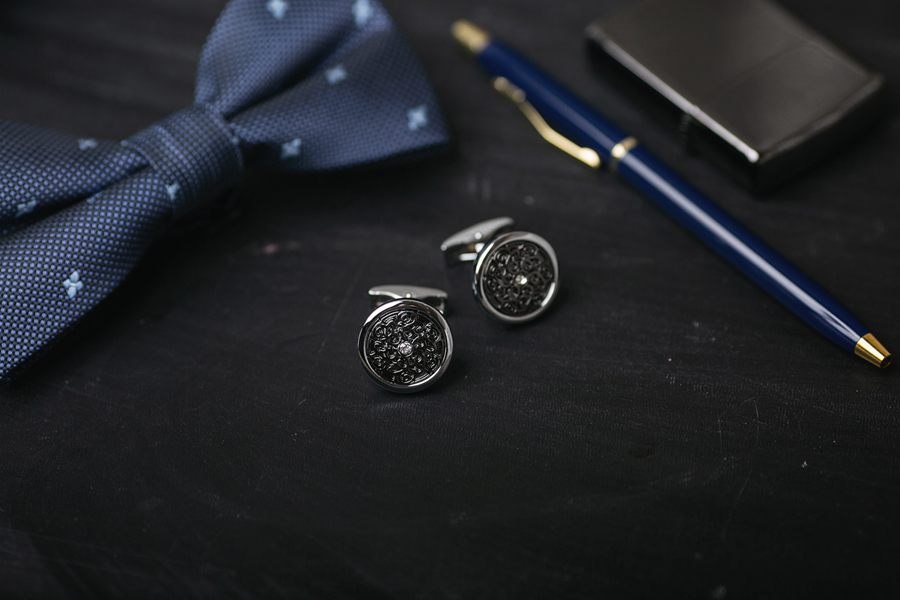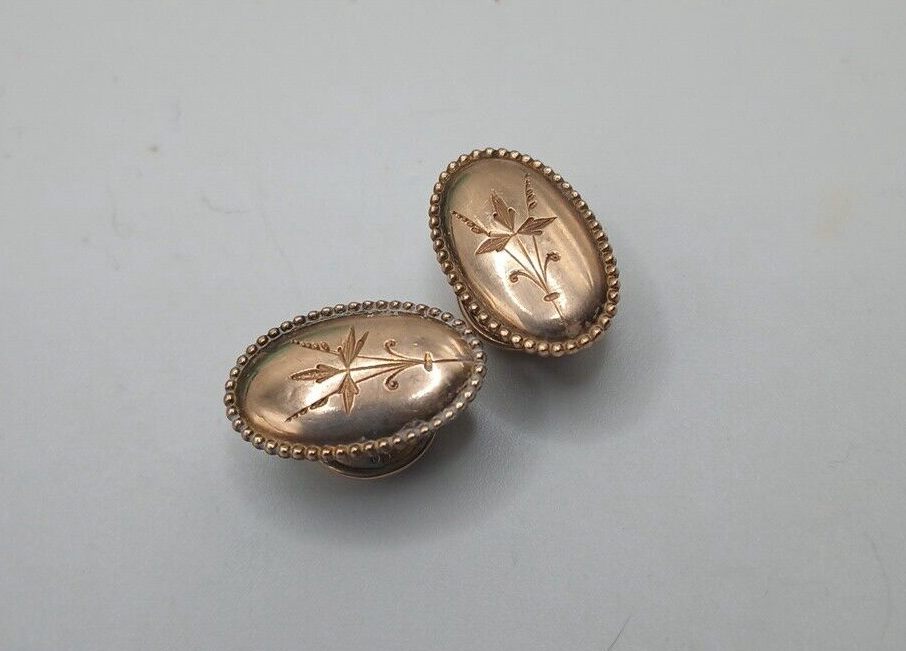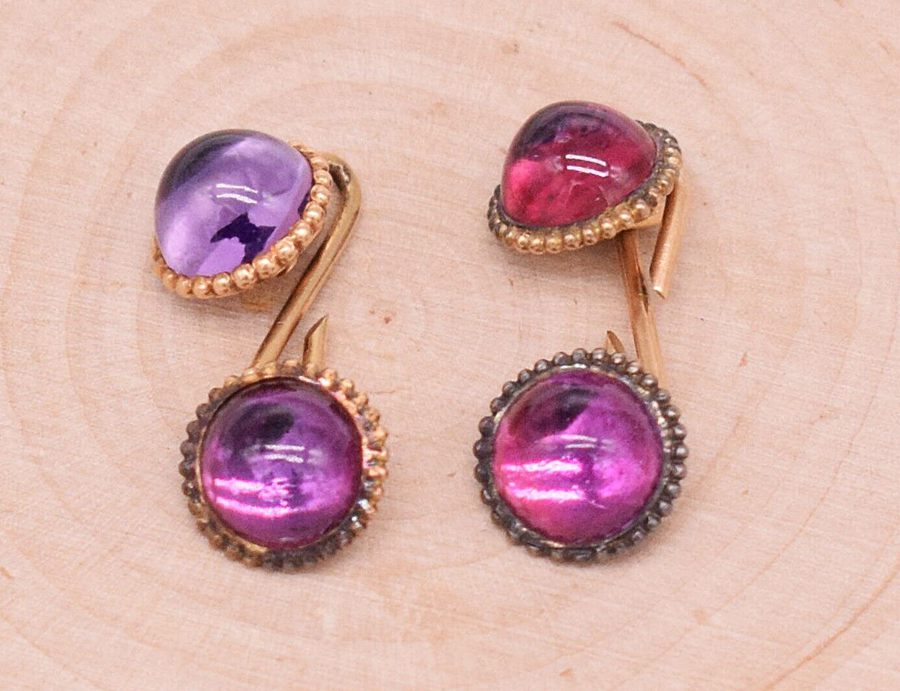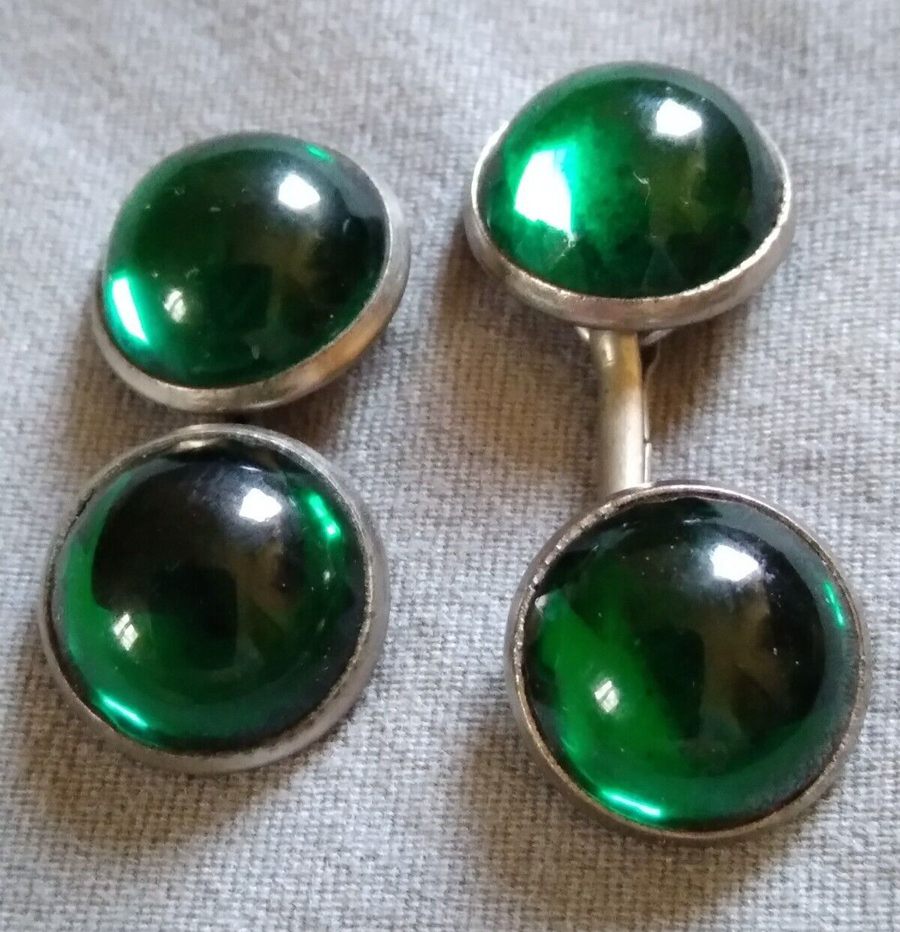Delving into the world of antique cufflinks, you’ll uncover a fascinating realm of miniature masterpieces that captivate with their elegant designs and unique history. From the 17th-century France to the present day, antique cufflinks have stood as symbols of status and refinement, offering distinctive styles that cater to various tastes. This article will guide you through the intricate art of identifying, understanding, and valuing these timeless accessories.
As you explore antique cufflinks, you’ll come across different types, such as fixed, double-sided, chain, or toggle. Each type offers its own charm and characteristics, with fixed or double-sided cufflinks often being the most sought-after for their age and rarity. You will also learn about the various materials used to create vintage cufflinks—ranging from silver and gold to more unusual elements like quartz—and discover notable brands, including Cartier, Tiffany & Co., and Bulgari.
In your quest for antique cufflinks, understanding their design and history will play a crucial role in determining their value. By immersing yourself in the captivating stories behind these accessories, you’ll soon develop a keen eye for details and be prepared to distinguish between truly exceptional pieces and common reproductions. Get ready to embark on an enchanting journey through the world of antique cufflinks.
Table of Contents
The History & Evolution of Antique Cufflinks
During the 14th century, ribbons and strings were used to hold together the cuffs of men’s shirts. But it wasn’t until the late 17th century that cufflinks started to gain popularity. As you explore the world of antique cufflinks, you will find that their design, identification, and value have evolved significantly over the years.
In the early 18th century, cufflinks were made from a variety of materials such as glass, precious stones, and gold. These early cufflinks typically featured designs that were either simple or ostentatious, depending on the wealth and social status of the individuals wearing them. As a collector of antique cufflinks, you should pay attention to the craftsmanship of these early designs, as they can provide insight into their historical context and rarity.
Moving forward into the 19th century, you will notice a shift in fashion trends and manufacturing innovations. The Industrial Revolution brought about mass production, making cufflinks more affordable and accessible to the general population. This period saw the introduction of more complex and intricate designs, often featuring images or motifs of historical events, nature, or geometric patterns. Look for cufflinks with unusual designs or motifs, as they can potentially be more valuable.
By the time you reach the early 1900s, the Art Nouveau and Art Deco movements significantly influenced cufflink design. Art Nouveau designs included organic, flowing lines and delicate floral patterns, while Art Deco designs featured geometric shapes, bold lines, and contrasting colors. Pay attention to the design elements, material, and level of detail when identifying cufflinks from these periods, as their value can vary greatly.
Throughout the 20th century, cufflink styles continued to evolve. Materials such as sterling silver, enamel, and even plastics became common in cufflink production. Designs ranged from simple and modern to elaborate and ornate. As you identify and evaluate cufflinks from this period, consider factors such as designer, material, rarity, and condition.
In summary, the history and evolution of antique cufflinks can be seen through their shifting designs, materials, and manufacturing techniques. By becoming familiar with these historical trends and details, you will be better equipped to identify and assess the value of the antique cufflinks you encounter in your collecting journey.
How to Tell if a Cufflink is Antique or Old
To determine if your cufflink is antique or old, follow these steps:
- Examine the materials and craftsmanship: Antique cufflinks often feature precious metals like gold, silver, or platinum. Check for hallmarks or stampings that may indicate the material’s purity or the manufacturer’s name. Additionally, antique cufflinks are typically crafted with intricate details, which reveal their old-world craftsmanship.
- Look for recognizable brands: Some notable antique cufflink brands include Cartier, Tiffany & Co., Bulgari, Larter & Sons, Deakon & Francis, J.E. Caldwell & Co., Carrington & Co., Krementz & Co., and Hemmerle. Finding these names on your cufflinks is a good indication of their vintage status.
- Inspect the connecting mechanisms: Antique cufflinks often have different mechanisms compared to modern ones. For instance, if your cufflinks have a coin-like, mesh, or designer back, they may be from the 1800s. Other styles, such as wrap-around or oblong shapes, can also suggest an older origin.
- Evaluate the design: Vintage cufflinks were often more intricate, bold, and colorful than their modern counterparts. Pay attention to the level of detail, the colors, and the overall artistry of the design. In some cases, older cufflinks may depict unique themes or motifs that are not commonly seen today.
- Research your findings: Finally, compare your observations against reliable resources on antique cufflinks, such as collector’s guides, museum websites, or reputable auction house listings. This will help you verify the age and authenticity of your cufflinks as you gain more insights into their value.
Remember, accurately identifying antique cufflinks can require expertise and a keen eye for detail. If you’re unsure, consider seeking advice from a knowledgeable collector or a professional appraiser who specializes in antique and vintage jewelry.
Design and Materials
Gold and Silver
When collecting antique cufflinks, you’ll often come across designs made from gold and silver. These precious metals have a long history of use in cufflink design, with many luxury brands, such as Tiffany & Co., offering exquisite pieces in these materials. Gold and silver cufflinks can vary in style and value, often dependent on the karat or purity of the metal, as well as the brand.
Sterling Silver
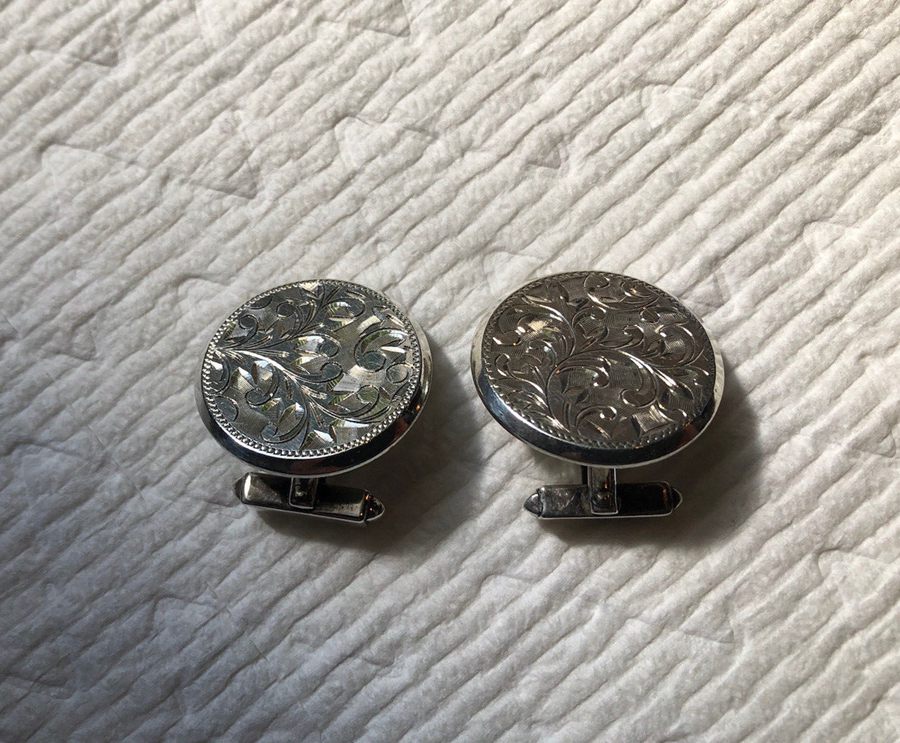
Sterling silver is another popular material for antique cufflinks. This alloy is made up of 92.5% pure silver and 7.5% of other metals, typically copper. Sterling silver cufflinks often have intricate designs and patterns, and usually bear a hallmark for identification.
Gemstones and Diamonds
As part of the design, many antique cufflinks feature various gemstones or diamonds. They might be set as a centerpiece or as accents, depending on the cufflink’s style and period. Collectible cufflinks can showcase various gemstones like sapphires, rubies, or emeralds, as well as diamonds. The value of gemstone cufflinks depends on the rarity, type, and quality of the stones.
Glass and Leather
Antique cufflinks made from glass or leather materials offer a unique, more casual alternative to precious metals and gemstones. Glass cufflinks, for example, may have lampwork or hand-painted designs, while leather cufflinks typically feature embossed patterns.
Chain-Link

Chain-link cufflinks are a common style that connects the two cuff faces with a short chain, often allowing for double-sided or reversible designs. This style is popular in Europe and is favored at formal events like weddings or black-tie affairs.
Bullet Back and Whale Back Cufflinks
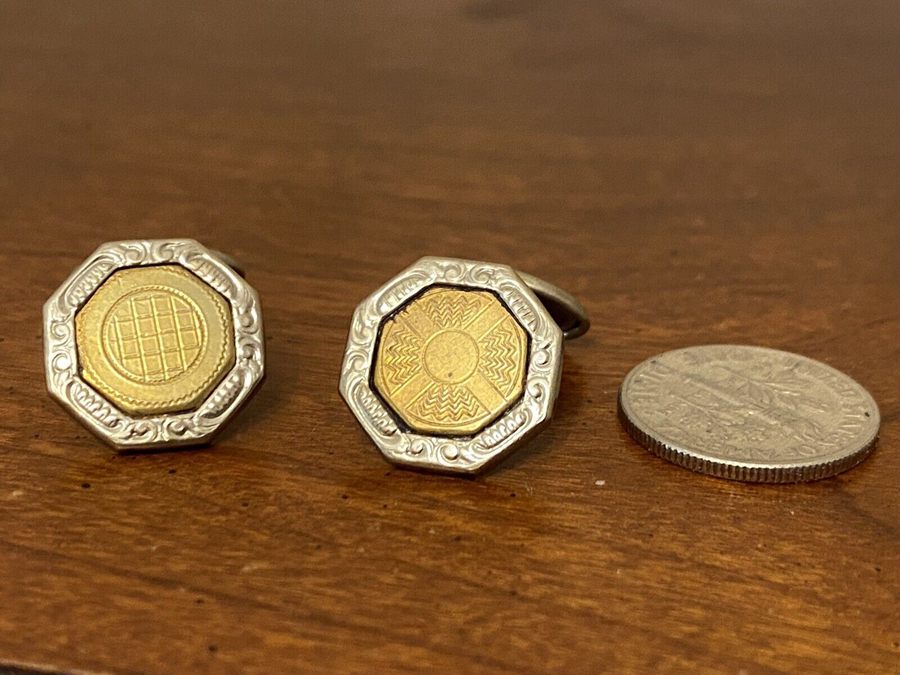
Two other styles of cufflinks to consider are bullet back and whale back cufflinks. Bullet back cufflinks feature a small cylinder-shaped toggle, set between two short bars, that is flipped 90 degrees to secure the cufflink. On the other hand, whale back cufflinks earned their name due to the whale tail-shaped toggle used for securing.
To sum up, antique cufflinks can be found in numerous materials, styles, and designs. As a collector, consider exploring various types, such as gold and silver, sterling silver, gemstones and diamonds, glass and leather, and chain-link cufflinks. Each offers a distinct appeal, as well as different levels of value and rarity.
Popular Designers
Tiffany & Co.
When it comes to antique cufflinks, Tiffany & Co. is a well-known designer. Established in 1837, this brand is recognized for its elegant and high-quality jewelry pieces. With antique Tiffany cufflinks, you can expect stylish designs featuring precious metals, like gold and silver, combined with gemstones and intricate engravings. They often have a timeless appeal that matches both formal and casual attire.
Cartier
Another renowned designer in the world of antique cufflinks is Cartier. Founded in 1847, this luxury brand has produced exceptional jewelry and accessories for over a century. Cartier cufflinks are known for their exquisite craftsmanship and innovative designs, often incorporating platinum, gold, and precious gemstones like diamonds, sapphires, and emeralds. The creative use of materials and attention to detail can be appreciated in their vintage cufflinks, making them highly sought after by collectors and enthusiasts.
Louis XIV
Louis XIV, also known as the Sun King, was a patron of the arts and exerted significant influence on the world of jewelry during his reign. In the 17th century, ornate cufflinks became a symbol of wealth and status, with designs featuring precious metals, gemstones, and intricate motifs. Under Louis XIV’s influence, elegant cufflinks rose in popularity and set a new standard for men’s fashion accessories.
Some notable details of antique cufflinks from these designers include:
- Tiffany & Co.: Timeless designs, precious metals, gemstones, and intricate engravings.
- Cartier: Exceptional craftsmanship, innovative designs, and use of platinum, gold, and precious gemstones.
- Louis XIV: Ornate cufflinks with precious materials and artistic motifs.
By knowing more about popular designers like Tiffany & Co., Cartier, and Louis XIV, you can better identify and appreciate the beauty and craftsmanship of antique cufflinks in your collection.
10 Factors to Identify & Value Antique Cufflinks
1. Age
The age of antique cufflinks can provide valuable information about their design, identification, and value. Cufflinks have been popular accessories since the 17th century, but their designs and materials have evolved significantly over time. Understanding the different eras and styles of vintage cufflinks can help you accurately identify and value these collectible accessories.
Time Periods and Associated Styles
Below are the main time periods during which cufflinks gained popularity, along with their associated styles:
- Georgian Era (1714-1837): Cufflinks from this time tended to be simple in design, often featuring repoussé, enamel, or gemstones.
- Victorian Era (1837-1901): Cufflinks from this period featured intricate designs, sometimes including symbols of love, friendship, or mourning.
- Edwardian Era (1901-1910): Cufflinks in this era were more delicate and refined, often showcasing platinum, diamonds, and other precious gemstones.
- Art Deco Era (1920s-1930s): Cufflinks from the Art Deco period were characterized by geometric patterns, bold colors, and exotic materials like mother-of-pearl and onyx.
Factors Affecting Value
Several factors can affect the value of antique cufflinks, such as:
- Condition: Cufflinks in good condition, with minimal signs of wear, will generally be more valuable than those with visible damage or wear.
- Rarity: Unique or rare cufflinks, or those from limited production runs, may be more valuable due to their scarcity.
- Materials: Cufflinks made from high-quality materials, such as gold, platinum, or precious gemstones, will typically have higher values than those made from less expensive materials.
2. Manufacturer
When identifying antique cufflinks, it is important to consider the manufacturer, as some luxury brands are known for their high-quality designs and craftsmanship. Some popular brands that manufactured cufflinks include:
- Bvlgari
- Verdura
- Cartier
- Tiffany & Co. / Elsa Peretti
- Hermès
- Prada
- Harley Davidson
- Van Cleef & Arpels
- Asprey
- Victor Mayer
- Pforzheim
- David Webb
- Georg Jensen
- Royal Copenhagen
Keep in mind that not all antique cufflinks will be marked with a manufacturer’s stamp. Some of the early examples, especially from the 19th century, might be unmarked. However, companies like Swank and Krementz marked their products, which can assist in identification.
In determining the value of your antique cufflinks, the manufacturer plays a significant role. Here is a valuation table showcasing the average valuation for different brands:
| Brand | Average Valuation |
|---|---|
| Bvlgari | $800 – $1,000 |
| Cartier | $1,500 – $2,000 |
| Tiffany & Co. | $1,000 – $1,500 |
| Hermès | $700 – $1,000 |
| Van Cleef & Arpels | $2,000 – $2,500 |
| Asprey | $1,500 – $2,000 |
| David Webb | $1,500 – $1,800 |
| Georg Jensen | $500 – $1,000 |
Keep in mind that this table provides average values and the actual value of individual cufflinks can vary depending on factors such as design, material, age, and condition.
3. Materials
When it comes to antique cufflinks, the materials used in their construction play a significant role in their value. Here are the most common materials you’ll come across:
- Gold: A timeless choice, gold cufflinks often have a classic appeal. Their value varies depending on the karat of the gold (higher karats indicate a higher gold content).
- Silver: Another popular option, silver cufflinks can range from simple and understated to intricately detailed. Sterling silver is the most common form, and its value can fluctuate with the silver market prices.
- Gemstones: Antique cufflinks may feature various gemstones, both genuine and synthetic. Their value depends on the gem’s rarity, quality, and overall appearance.
- Enameling: Some cufflinks have intricate enameling that adds a decorative touch. The quality of the enameling work can affect the value of the cufflinks, with well-executed designs commanding higher prices.
- Mother of pearl: Many 19th and 20th-century cufflinks incorporated mother of pearl, resulting in elegant designs.
Here’s a table with estimated valuations for antique cufflinks based on various factors:
| Material | Average Valuation |
|---|---|
| 18-carat gold (no stones) | $300 – $400 |
| 18-carat gold with gemstones | $500 – $800 |
| Sterling silver (no stones) | $100 – $200 |
| Sterling silver with gemstones | $200 – $400 |
| Enameled | $150 – $250 |
| Mother of pearl | $80 – $150 |
4. Gemstones
Precious Gemstones
When assessing antique cufflinks, one essential factor to consider is the type of gemstone used. In general, more valuable gemstones result in higher value cufflinks. Classic precious gemstones found in antique cufflinks are:
- Diamonds
- Sapphires
- Rubies
- Emeralds
- Pearls
These precious gemstones are often used to accent a design or serve as a focal point in antique cufflinks, enhancing their elegance and value.
Semi-Precious Gemstones
In addition to precious gemstones, semi-precious gemstones can also be found in antique cufflinks. While they may not be as valuable as their precious counterparts, these gemstones still contribute to the overall appeal and worth of the cufflinks. Some semi-precious gemstones commonly found in antique cufflinks include:
- Onyx
- Garnet
- Topaz
- Amethyst
- Lapis Lazuli
To help you with valuations, here is a table outlining the average prices for antique cufflinks with various gemstones:
| Gemstone | Average Valuation |
|---|---|
| Diamonds | $800 – $2,000 (depending on size and quality) |
| Sapphires | $500 – $1,500 (depending on size and quality) |
| Rubies | $500 – $1,500 (depending on size and quality) |
| Emeralds | $400 – $1,000 (depending on size and quality) |
| Pearls | $300 – $800 (depending on size and quality) |
| Onyx | $100 – $300 |
| Garnet | $100 – $300 |
| Topaz | $100 – $300 |
| Amethyst | $100 – $300 |
| Lapis Lazuli | $100 – $300 |
Keep in mind that the actual value of your antique cufflinks will depend on various factors, such as the design, quality of the gemstone, and the cufflink type. Happy treasure hunting!
5. Design
The design of antique cufflinks has evolved over the years. While the primary function remains the same, which is to fasten the ends of shirt sleeves, the decorative elements and styles have changed. Here, we will explore some of the most common design types in antique cufflinks.
Fixed or Stud Cuffs
These cufflinks don’t have hinges but do have stable backs, posts, and interior heads. They also have small buttonholes and a unique sliding-screwing lock. They are sturdy and can cost between $50 to $400, depending on the design.
Double-sided Cufflinks
With a chain link connecting the two decorative elements, this classic style is quite formal and a normal sight at weddings and black-tie affairs. These cufflinks give designers the ability to create reversible designs.
Bullet-back Cufflinks
Bullet-back models are popular due to their ease of use. This type features a small cylinder shaped like a bullet that is set between two short bars and is flipped 90 degrees to secure.
Whaleback Cufflinks
Whaleback cufflinks get their name from the toggle shaped like a whale’s tail to secure. These types of cufflinks have a more simplistic and modern appearance.
Factors that affect the value of these different types of cufflinks include materials used, the presence of gemstones, and the overall condition of the cufflinks. Here is a valuation table for the designs covered:
| Design | Average Valuation |
|---|---|
| Fixed or Stud | $50 – $400 |
| Double-sided | $150 – $1,200 |
| Bullet-back | $150 – $800 |
| Whaleback | $70 – $500 |
6. Symbolism
Antique cufflinks often feature various symbols and motifs representing different meanings, which can impact their value. Here are a few examples of symbolism found in antique cufflinks and their interpretations:
- Animals: Animals often symbolize certain characteristics, such as strength, courage, or wisdom. For example, lions represent courage and authority, while snakes symbolize eternity or transformation.
- Floral motifs: Flowers can represent love, beauty, and growth or embody specific sentiments, like the Victorians’ language of flowers. For example, roses symbolize love and affection, while lilies represent purity and innocence.
- Geometric shapes: Shapes such as circles, squares, or triangles can represent unity, stability, or balance, respectively. They can also have cultural or religious significance in certain contexts.
7. Rarity
Antique cufflinks are valued based on several factors such as design, craftsmanship, material, and rarity of stones. In this section, we’ll discuss the rarity aspect and how it impacts the cufflinks’ valuation. To make your understanding easier, we’ve used tables to show average valuations based on rarity factors.
Rare Gemstones
Antique cufflinks from the 1800s often feature embedded gemstones that significantly affect their value. The rarer the gemstone, the higher the cufflinks’ value will be. Here’s a valuation table based on the rarity of gemstones:
| Gemstone Type | Average Valuation |
|---|---|
| Diamond | $1,000 – 1,500 |
| Ruby | $800 – 1,200 |
| Emerald | $700 – 1,000 |
| Opal | $600 – 800 |
| Coral | $500 – 700 |
| Synthetic or glass | $100 – 200 |
Designs and Styles
Cufflinks from different eras showcase various artistic designs that can also affect their overall value. Collectors often seek cufflinks from specific periods, such as Victorian or Art Deco. Here’s a valuation table based on the design and style of cufflinks:
| Design/Style | Average Valuation |
|---|---|
| Victorian | $600 – 800 |
| Art Deco | $500 – 700 |
| Monogrammed | $400 – 600 |
| High-end luxury | $1,000 – 2,000 |
Materials Used
The materials used in crafting antique cufflinks play a significant role in determining their value. Precious metals like gold and silver are more valuable, while alloys or base metals tend to be less valuable. Here’s a valuation table based on the material used:
| Material | Average Valuation |
|---|---|
| 14k Gold | $600 – 1,000 |
| Sterling Silver | $200 – 400 |
| Alloys/Base Metals | $50 – 150 |
As you dive deeper into the world of antique cufflinks, consider these factors to make more informed decisions in identifying and valuing these timeless treasures.
8. Condition
When it comes to antique cufflinks, the condition plays a crucial role in determining the value. A cufflink in excellent condition, with minimal wear and tear, will be worth more compared to one with visible damages or missing parts. In this section, we’ll discuss the impact of various factors on the condition and value of antique cufflinks.
Final Thoughts
As you explore the world of antique cufflinks, it’s essential to remember that their design, identification, and value play a crucial role in determining their appeal and worth. When examining different types of vintage cufflinks, always consider their material, design, and rarity.
FAQ
How can you tell if your antique cufflinks are real gold?
To identify if your cufflinks are made of real gold, look for any hallmarks or stamps indicating gold content (e.g., 18K or 750). If there are no clear markings, you can also perform a simple test with a small magnet; if the cufflinks are attracted to the magnet, it usually means they are not real gold, as gold is not magnetic.
How do you clean old cufflinks?
Cleaning your old cufflinks requires delicate care. Here’s a basic guideline:
- Mix a few drops of mild dish soap with warm water in a small bowl.
- Gently brush the cufflinks with a soft-bristle toothbrush dipped in the water and soap mixture.
- Rinse the cufflinks gently under warm running water and ensure all soap residue is removed.
- Dry the cufflinks carefully with a soft cloth, avoiding excessive rubbing.
For cufflinks with gemstones, be extra cautious and consult a professional jeweler if needed.
How do you store old cufflinks?
Proper storage is essential to preserve the condition and value of your old cufflinks. Consider using a jewelry box or compartmentalized storage container with soft lining to protect them from scratches and damage.
What are some key factors in determining the value of antique cufflinks?
Several factors influence the value of antique cufflinks:
- Age: Older cufflinks are often more valuable than newer ones.
- Material: Precious metals like gold, silver, and platinum usually add value.
- Gemstones: The presence and quality of gemstones can increase the value.
- Brand or maker: Renowned makers like Cartier or Tiffany & Co. tend to increase the value.
- Condition: Cufflinks in excellent condition with few signs of wear will typically have a higher value.
- Rarity: Unique, rare, or one-of-a-kind designs are likely to be more valuable.
Remember that determining the value of antique cufflinks is complex, and consulting a professional appraiser or jeweler is always recommended.

